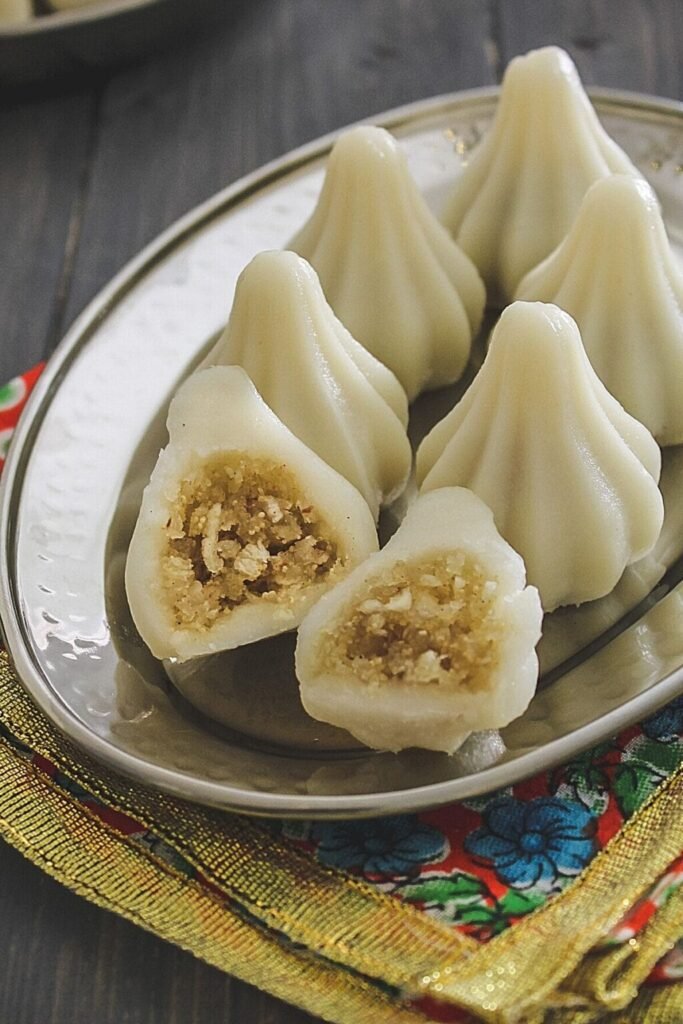Ukadiche Modak represents a traditional Maharashtrian sweet delicacy that devotees offer to Lord Ganesha, especially during the Ganesh Chaturthi festival. The word ‘ukadiche’ translates to ‘steamed’ in Marathi, perfectly describing these soft modaks with a delicate rice flour shell. Inside, a sweet coconut-jaggery filling melts in your mouth, creating a delightful blend of textures. The chewy, flavorful interior and pillowy outer layer make this treat not only a festive favorite but also a heartfelt spiritual offering symbolizing purity and devotion.
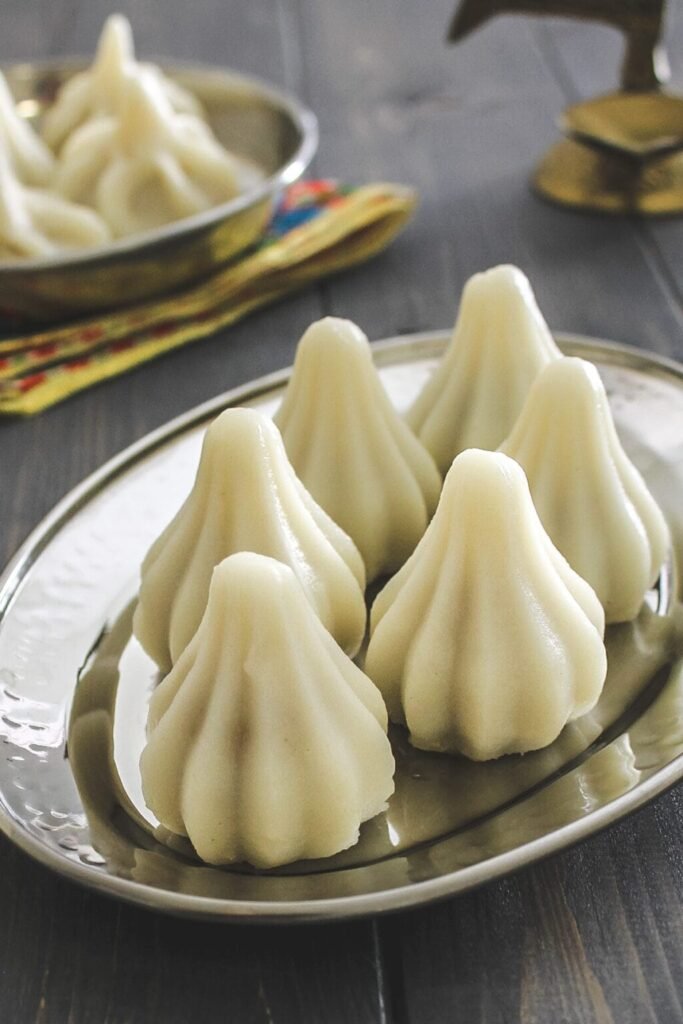
Why Ukadiche Modak is Special
Unlike the fried versions, Ukadiche Modak is gently steamed, which gives it a light and soft texture. The outer layer is made using soft rice flour dough, encasing a flavorful mixture of fresh coconut, jaggery, and aromatic cardamom that gives it a naturally sweet and fragrant taste. When steamed to perfection, these modaks become glossy, tender, and subtly aromatic — just the way Bappa loves them!
What is Ukadiche Modak?
Ukadiche Modak – A Festive Maharashtrian Treat Loved by Lord Ganesha
The word “Ukadiche” comes from Marathi and translates to “steamed.” Modak refers to a sweet dumpling, and among its many variations, Ukadiche Modak holds a special place, especially during Ganesh Chaturthi. Families across Maharashtra prepare this classic delicacy on the very first day of Ganesh Chaturthi as a sacred offering (Prasad) to Lord Ganesha, who is believed to love modaks more than any other sweet. Deeply rooted in festive traditions, this sweet holds a special place in every devotee’s heart.
Cooks prepare these soft, steamed modaks using three simple yet aromatic ingredients—rice flour, jaggery, and freshly grated coconut—all staples in Maharashtrian kitchens. Despite the simplicity of the ingredients, making Ukadiche Modak demands patience and care, turning the process into a true labor of love.
Making Ukadiche Modak involves three main stages, each contributing to its delicate texture and rich flavor:
1) Preparing the Filling: A sweet mixture is cooked using freshly grated coconut and jaggery, flavored with cardamom. This forms the rich, moist center of the modak and gives it its signature taste.
2) Making the Dough: The outer covering is prepared by cooking rice flour in hot water with a touch of ghee and salt, then kneading it into a soft, pliable dough while still warm.
3) Shaping and Steaming: Small portions of the dough are filled with the coconut-jaggery mixture, pleated into the traditional modak shape, and then steamed until tender and slightly translucent.
Though these homemade steamed modaks demand a bit more time and effort than many other sweets, the outcome is incredibly rewarding—soft, aromatic, and absolutely divine. A true celebration of devotion and tradition on every plate!
Lord Ganesha’s Favorite Food: Modak
This traditional Ukadiche Modak holds a special place in the hearts of devotees, as it is believed to be one of Lord Ganesha’s most cherished sweets. During Ganesh Mahotsav, these steamed rice flour dumplings are lovingly prepared and offered to Ganpati Bappa as prasad (also called naivedya). Every modak is crafted with love, devotion, and precision, serving as a sacred offering filled with emotion and reverence, far beyond being just a festive dessert.
Ukadiche Modak, with its tender rice flour casing and rich coconut-jaggery stuffing, goes beyond being a delightful sweet—it holds a cherished place in Maharashtrian culture and reflects deep spiritual traditions. Devotees traditionally offer these modaks to Lord Ganesha on the first day of Ganesh Chaturthi and continue preparing them throughout the 10-day celebration.
To celebrate this auspicious occasion, I’ve curated a collection of 10 unique and delicious modak recipes—from classic steamed versions to creative fusion flavors. Whether you stick to tradition or want to try something new, these recipes are sure to bring joy to Bappa and your family alike.
Apart from modaks, ladoo is another favorite sweet associated with Lord Ganesha. Variants like besan ladoo, coconut ladoo, and rava ladoo are often included in the festive offerings.
In addition to sweets, many families also prepare savory dishes as part of the bhog. People traditionally serve dishes like poori-bhaji, varan-bhaat (dal-rice), rice poori, and Rishi Panchami bhaji during the festival. They prepare these humble, sattvic meals without onion and garlic to honor the purity and spiritual significance of the occasion.
Together, these offerings form a wholesome, heartfelt naivedya to Bappa, celebrating not only the festival but also the spirit of gratitude, tradition, and community.
Ingredients for Ukadiche Modak Recipe
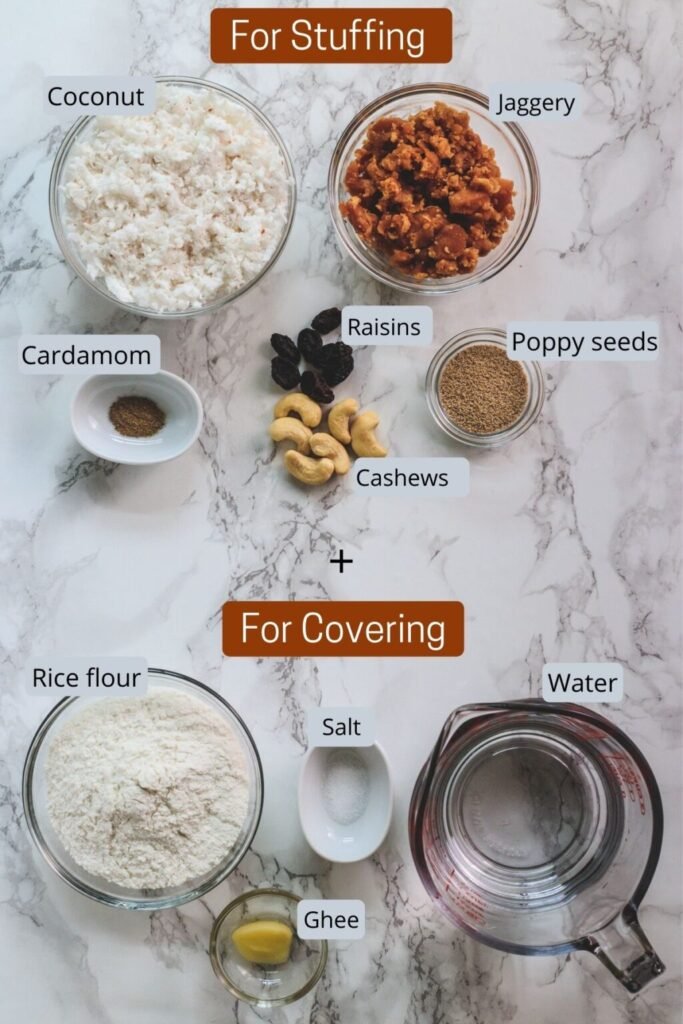
- Coconut: Finding fresh coconut in the U.S. can be quite challenging. That’s why I usually opt for frozen grated coconut, which is available in Indian or Asian grocery stores. It offers the same fresh flavor and texture, making it an excellent substitute. While some people use dry desiccated coconut as an alternative, it lacks the natural moisture and richness. If available, go for frozen coconut—it comes closest to the traditional taste of fresh.
- Jaggery: The color of your coconut-jaggery filling may vary depending on the type of jaggery you use. For example, in the main recipe image, I used a dark jaggery, giving the filling a deep caramel-like hue. However, in some of my older step-by-step photos (shot in 2015), you’ll notice a lighter jaggery, resulting in a pale golden stuffing. Both work well, and flavor-wise, there’s not much difference—it’s mainly an aesthetic preference.
- Poppy Seeds (Khuskhus): Adding white poppy seeds is optional, but it does enhance texture and richness. These are white poppy seeds, not the black kind you typically find on bagels. Lightly toasting them before mixing with the filling adds a nutty aroma and delicate crunch.
- Rice Flour: I use regular rice flour readily available at Indian grocery stores. It works well, especially if you’re using a modak mold for shaping. However, if you plan to shape modaks by hand—creating those traditional pleats—this rice flour can be slightly tricky. The dough may crack or tear, making it harder to achieve neat, shop-style modaks.
Mix in 2 teaspoons of glutinous rice flour—readily available at Asian supermarkets—to improve the dough’s elasticity and prevent it from breaking while pleating. This simple addition makes the dough smoother, more flexible, and easier to shape by hand.
How To Make Ukadiche Modak?
1) In a heavy-bottomed pan, combine grated coconut and jaggery over medium heat.
2) As the jaggery begins to melt, the mixture will turn soft and slightly watery. Keep stirring and let the mixture cook until it reduces and becomes thick, with most of the moisture drying up. This typically takes around 6–7 minutes, but timing may vary based on how moist your ingredients are. Keep a close watch to avoid burning.
3) Once the mixture thickens, stir in white poppy seeds (khuskhus), chopped cashews, raisins, and a pinch of cardamom powder for a burst of aroma.
4) Mix everything well and cook for an additional minute. Turn off the heat, transfer the mixture to a plate, and allow it to cool completely before using.
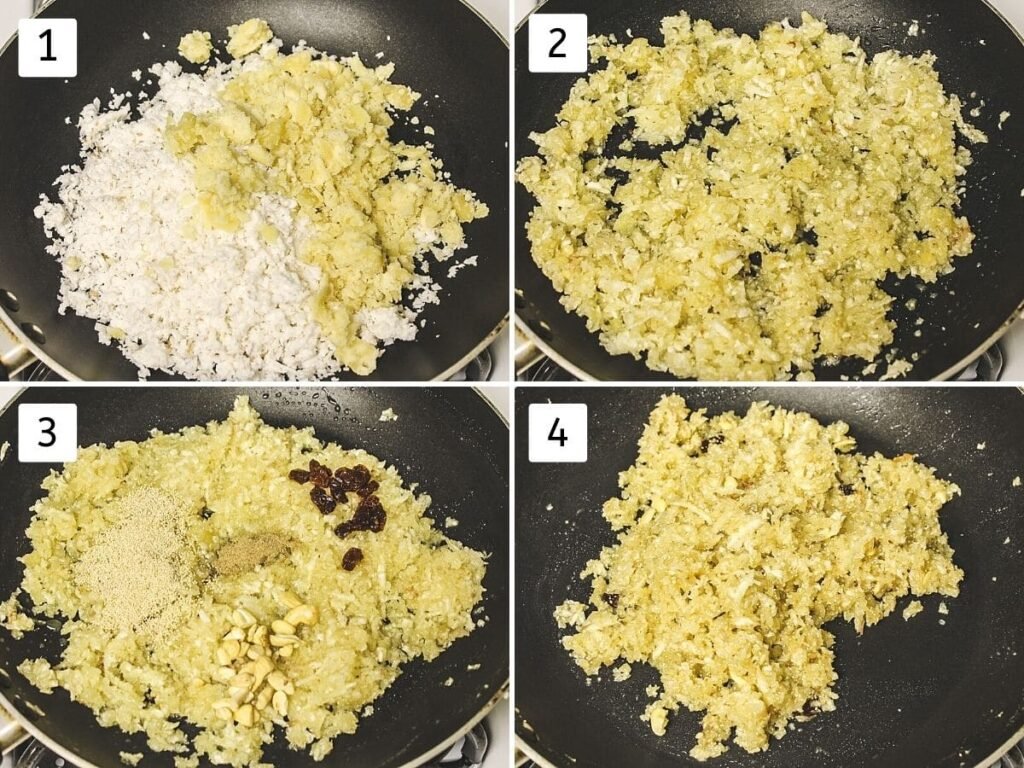
5) In a saucepan, bring water to a boil and stir in a teaspoon of ghee. Maintain the flame on medium-low.
6) Pour in the rice flour all at once and stir quickly to blend it into the water, making sure no lumps form. Keep mixing until it comes together into a soft, flexible dough.
7) Place a lid over the pan and allow the mixture to steam for 2–3 minutes, stirring occasionally to ensure it cooks uniformly without sticking.
8) Spread the warm dough onto a flat plate and let it rest for a few minutes until it’s cool enough to knead by hand.
9) While it’s still warm, begin kneading. If the dough feels too hot, dab a little water on your palms and continue kneading until smooth and pliable.
10) The dough needs to be smooth, lump-free, and slightly soft to the touch, with a non-sticky texture that makes shaping easy.

Shaping Modaks – Method 1: Using a Mould
1) Apply a thin layer of ghee inside the modak mould to prevent the dough from sticking.
2) Insert a small amount of dough into the mould and carefully press it to evenly cover the inner surface.
3) Use your finger to gently shape the dough along the mould walls, creating a hollow center.
4) Fill the cavity with about 1–2 teaspoons of the coconut-jaggery filling and gently press it down.
5) Cover the base with a small piece of dough and seal it well.
6) Gently separate the mould halves and release the shaped modak without breaking it. Set it aside on a plate and cover with a damp cloth to prevent drying while you shape the rest.
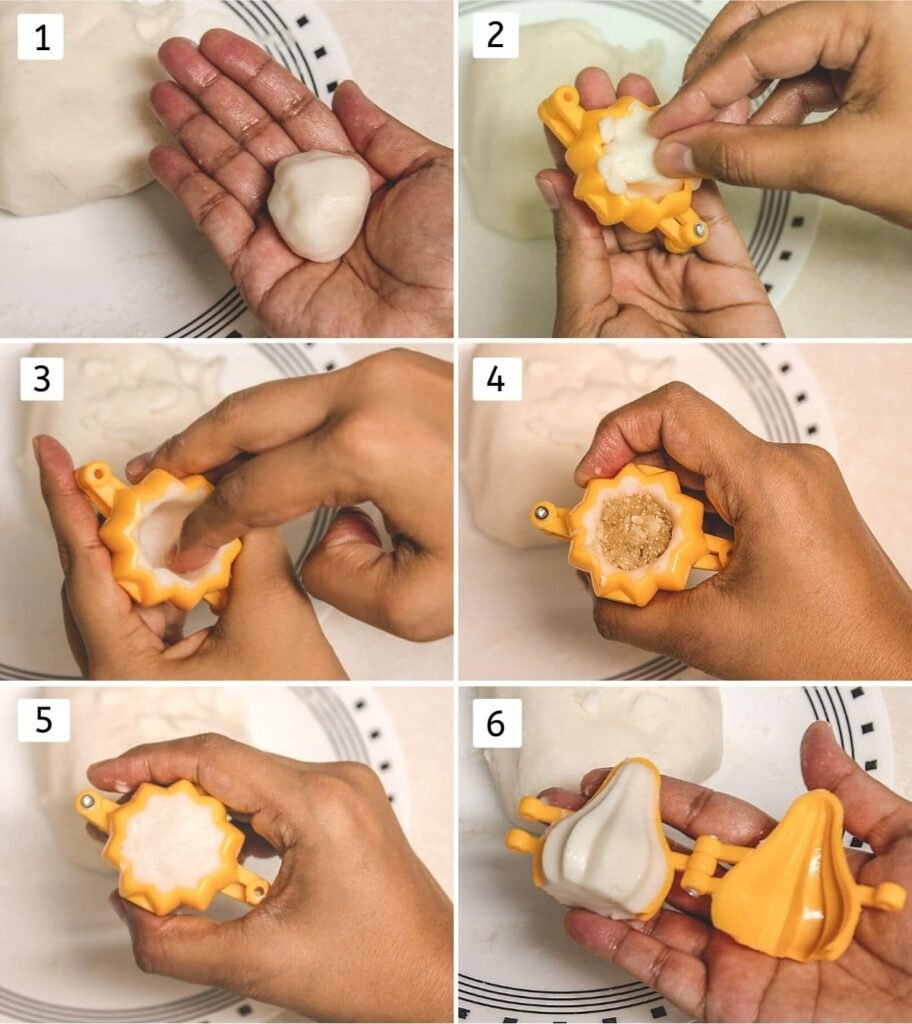
Shaping Modaks – Method 2: Shaping by Hand
1) Rub a little ghee on your hands or dampen them with water, then place a portion of the dough onto your palm.
2) Flatten the ball into a small disc using your fingers and palm.
3) Now, gently press and stretch the edges to form a shallow cup about 3–4 inches in diameter, keeping the center slightly thicker.
4) Add 2–3 teaspoons of the cooled filling into the center.
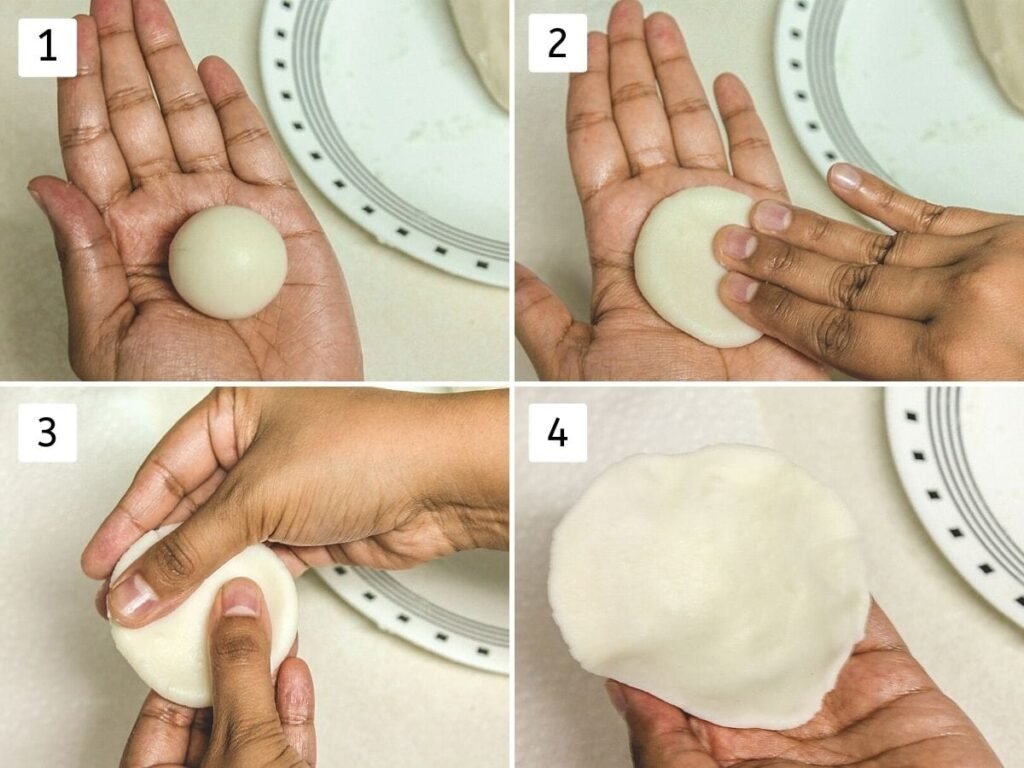
5 & 6) Use your thumb and forefinger to gently pinch along the outer rim, creating pleats around the edge. Begin by making 5 pleats, and as you gain experience, you can increase the number for a more authentic and elegant appearance.
7) Delicately gather all the pleated edges at the center and pinch them together at the top, sealing the modak firmly and giving it its signature pointed shape.
8) If you notice the dough cracking during shaping, try incorporating 2 teaspoons of glutinous rice flour into the mixture while preparing the dough to improve its flexibility.
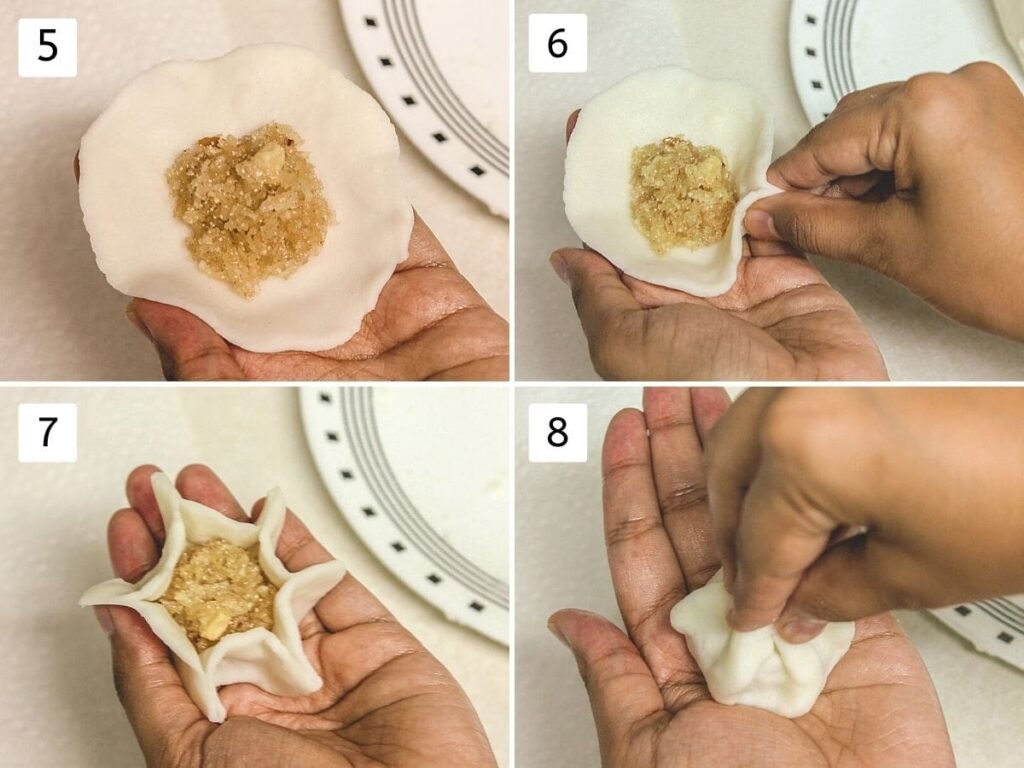
Steaming the Modaks to Perfection:
1) As you work on shaping each modak, make sure to cover the rest with a clean, damp muslin cloth or kitchen towel. This helps retain the dough’s moisture and prevents it from drying out or cracking.
2) Prepare the steamer by bringing water to a boil. Meanwhile, lightly brush each modak with water to keep the outer surface moist. You can also gently immerse each modak in water for a few seconds to help retain moisture before placing them in the steamer.
3) Line your steamer plate with banana leaf, parchment paper, or a muslin cloth to prevent sticking. Place the modaks with some space in between.
4) Steam the modaks over medium heat for 13–15 minutes. Once steamed, allow them to cool slightly—they will firm up as they rest.
5) Transfer them gently to a serving plate and drizzle with melted ghee or saffron-infused milk for an extra festive touch.

Expert Tips For PERFECT Modak Recipe
- Don’t Overcook the Filling: While preparing the jaggery and coconut mixture, keep a close eye on the texture. Overcooking the jaggery will make it hard and chewy, which can ruin the soft bite of a modak. Cook just until the mixture thickens and the excess moisture evaporates, then immediately take it off the heat to cool.
- Knead the Dough While Warm: It’s essential to knead the rice flour dough when it’s still warm. This makes the dough soft, flexible, and more manageable for shaping. If the dough sticks to your hands, don’t worry—grease your palms with a little ghee and knead gently until it’s pliable and lump-free.
- Aim for the Right Dough Consistency: Your dough should be soft, non-sticky, and completely free of cracks. A smooth, pliable dough is the key to shaping modaks without breakage and ensures a melt-in-the-mouth texture once steamed.
- Mind the Thickness of the Outer Layer: The rice flour shell should be of medium thickness. If it’s too thick, the modaks take longer to cook and taste overly doughy, disrupting the delicate balance between the outer layer and the sweet filling. On the other hand, if the shell is too thin, it may tear while pleating or burst open during steaming, causing the stuffing to leak out.
- Practice Makes Perfect: Shaping modaks—especially by hand—requires a bit of patience and practice. It’s perfectly normal if your initial modaks aren’t picture-perfect — with a little practice, your shaping skills will improve. With time, you’ll master the pleats and seal just like traditional home cooks!
